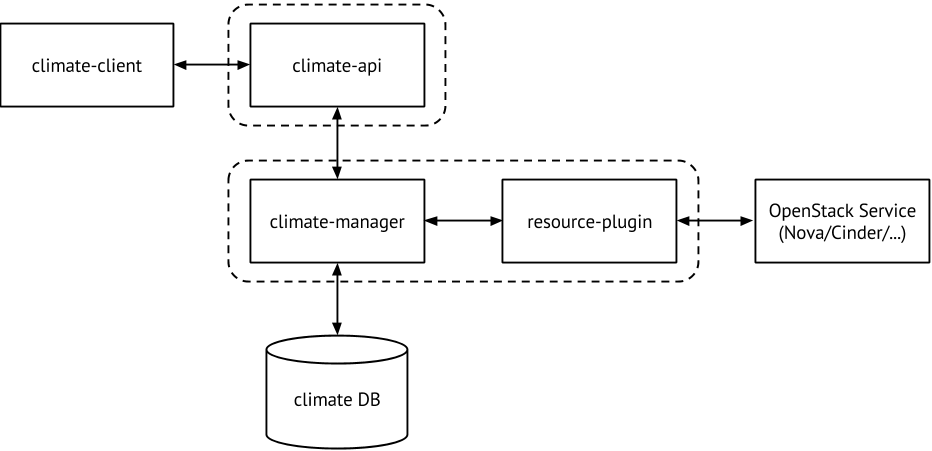Climate architecture¶
Climate design can be described by following diagram:

climate-client - provides the opportunity to communicate with Climate via REST API (climate-api service).
climate-api - waits for the REST calls from the outside world to redirect them to the manager. climate-api communicates with climate-manager via RPC. Runs as a separated process.
climate-manager - implements all logic and operations with leases, reservations and events. Communicates with Climate DB and stores there data structure of connected leases, reservations (both physical and virtual) and events. climate-manager service is responsible for running events created for lease and process all actions that should be done this moment. Manager uses resource-plugins to work with concrete resources (instances, volumes, compute hosts). climate-manager uses Keystone trusts to commit actions on behalf of user who has created lease before.
resource-plugin - responsible for exact actions to do with reserved resources (VMs, volumes, etc.) When working knows only about resource ID and token to use. All resource plugins work in the same process as climate-manager.
Virtual instance reservation¶
Virtual instance reservation mostly looks like usual instance booting for user - he/she only passes special hints to Nova containing information about future lease - lease start and end dates, its name, etc. Special Nova API extensions parse these parameter and use them to call Climate, passing to it ID of just created instance. If there is a need to reserve all instances in cloud (like in developer labs to automate process of resource reclaiming), default reservation extension might be used. By default it starts lease at the moment of request and gives it one month of lifetime.
During the time lease has not started yet, instance will be shelved.
Compute host reservation¶
Now process of compute hosts reserving contains two steps:
- admin marks hosts from common pool as possible to be reserved. That is implemented by moving these hosts to special aggregate;
- user asks for reserving of host with specified characteristics like:
- the region
- the availability zone
- the host capabilities extra specs (scoped and non-scoped format is accepted)
- the number of CPU cores
- the amount of free RAM
- the amount of free disk space
- the number of hosts
Technically speaking, resource ID here will be not host ID, because there might be many of them wanted. Resource here will be new aggregate containing reserved hosts. The time lease starts, user may use reserved compute capacity to run his/her instances on it passing special scheduler hint to Nova. When host is reserved, it’s not used for usual instance running, it might be used only when lease starts and only by passing reservation ID to Nova. That is implemented using special Nova Scheduler filter, that passes reservation ID to Climate and checks if user really can use reserved compute capacity.